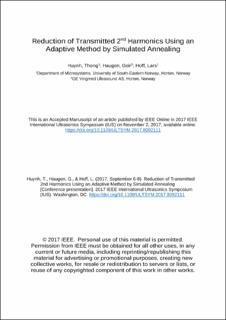Reduction of transmitted 2nd harmonics using an adaptive method by simulated annealing
Peer reviewed, Journal article
Accepted version
Permanent lenke
https://hdl.handle.net/11250/3010058Utgivelsesdato
2017Metadata
Vis full innførselSamlinger
- Institutt for mikrosystemer [546]
- Publikasjoner fra CRIStin [3619]
Originalversjon
Huynh, T., Haugen, G., & Hoff, L. (2017, September 6-9). Reduction of Transmitted 2nd Harmonics Using an Adaptive Method by Simulated Annealing [Conference presentation]. 2017 IEEE International Ultrasonics Symposium (IUS). Washington, DC. https://doi.org/10.1109/ULTSYM.2017.8092111Sammendrag
Second harmonic imaging relies on the double the transmit frequency being generated as the waves propagate into the tissue. The method requires good control over the transmit system, to suppress 2 nd harmonics transmitted from the transducer. These transmitted harmonics may originate from both linear, e.g. sidebands in the transmit spectrum, and nonlinear effects in the transducer and transmitting electronics. In this paper, an adaptive method, simulated annealing, was used to find optimized electrical excitation waveforms to suppress the 2 nd harmonic components of the emitted ultrasound pulses. The method was tested on one transmit system with a 3-level pulser and one with a 31-level pulser. Results show that the method can find excitation waveforms that generate 2 nd harmonic levels 30dB below the main lobe, which is assumed to be sufficiently low for 2 nd harmonic imaging.
